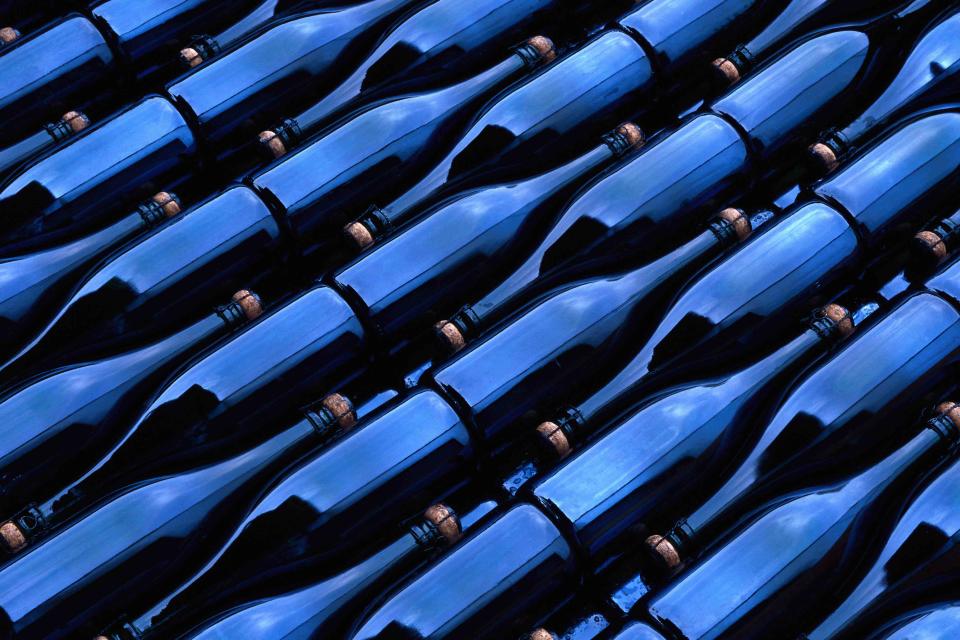Wait, Why Is Everyone Aging Liquor Underwater Right Now?
The ocean may be creating your next drink.

Charles O'Rear / Getty Images
From gin botanicals to vodka filtration, drink makers have long turned to the high seas for inspiration when it comes to brand identity and distillation techniques. But now, liquor brands seem more interested in what the bottom of the ocean can do for them instead, with more and more companies aging their wine and spirits underwater.
In Portugal’s Azores, Baleia Gin offers tourists the opportunity to place bottles on the ocean floor via a scuba dive excursion and pick them back up on their next visit. After years of resting under the sea, the bottles collect barnacles, seaweed, and other marine debris — becoming one-of-a-kind souvenirs. The idea started as a way to raise money for the Azores Whale Heritage Site and “to make the bottle look cool,” says founder Ali Bullock, noting that his intention was not to alter the gin’s flavor. “We've got seaweed in the base, so we don't want any more saltiness in there.”
But Trey Zoeller, founder of Jefferson's Bourbon, believes the ocean is the ultimate aging tool. Barrels of his Jefferson’s Ocean expression set sail on months-long voyages around the world. Far from a gimmick, he says the motion of the ocean “accelerates and enhances the maturation process.”
Related: Aging Wine Underwater Created 'Stunning' Difference, Says Winery
In fact, Zoeller’s father, a whiskey historian, believed boat travel inadvertently invented the concept of aged bourbon. Back in the day, Zoeller says people “were drinking it right off the still like vodka.” When Kentucky distillers began shipping the spirit by boat to the more populated regions of New England, “the journey that it took totally transformed that whiskey.” The bourbon that arrived after floating for 8-10 months had begun to take on a richer, deeper flavor, viscosity, and color.
While barrels aging on land are rotated every so often, the ocean current ensures Jefferson’s barrels are in near-perpetual motion, expediting the maturation process. “You're in constant contact with the wood, which brings more flavor and color,” Zoeller says. “That wood acts as a filter and takes out the astringency of the alcohol, so it makes it very easy-drinking.”
Some winemakers claim they’ve achieved a similar effect by aging bottles on the ocean floor, attributing low temperatures and increases in pressure to the wines’ accelerated maturation. One winemaker who aged bottles of Champagne at sea claimed the process imparted a slightly briny, mineral-forward flavor.
But before you start dreaming up your own aquatic collection, beware: Without the correct permits, the practice is actually illegal. California wine company Ocean Fathoms made the mistake of aging bottles at sea without Alcohol and Tobacco Tax and Trade Bureau (TTB) permissions — and was consequently forced to destroy thousands of wine bottles worth $500 a pop.
To make Jefferson’s Ocean a reality, Zoeller had to work closely with a TTB officer. “When we first told him what we wanted to do, he was like, ‘You want to export it and then import it without drinking it or doing anything with it? Are you laundering money?’” Once he explained the concept and got it approved, Zoeller filed the necessary paperwork and taxes upfront. “If you don't do that, you're gonna have to pour out your bottles as [Ocean Fathoms] did,” Zoeller says.
Because of this upfront taxation, Jefferson’s has to pay taxes on the angel’s share — the portion lost to evaporation. Aside from the added expenses associated with at-sea maturation, there are other potential downsides to the trend. Once bottles are placed underwater or set sail on a voyage, there’s no way to check their progress throughout the maturation process. “We've had a number of barrels that come back and are completely empty,” Zoeller notes.
Bullock also underscores the environmental impact of deliberately putting bottles on the seafloor. For this reason, he requires that every diver who drops a bottle also hauls some trash out of the ocean to offset any potential damage. He also ensures the bottles are well-secured so as not to float away and contribute to marine pollution. “We're really making sure that there's always more coming out the ocean than we're putting in,” he says.
From adding visual appeal to enhancing the aging process, the benefits of underwater maturation are shore to make this a lasting trend.
For more Food & Wine news, make sure to sign up for our newsletter!
Read the original article on Food & Wine.

